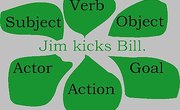The three basic verb tenses in the English language are the simple present, simple past and simple future tenses. By adding auxiliary words to verbs and participles, you can create as many as 30 additional tenses in English. However, these three major tenses are the foundations for all of them.
Simple Present Tense
The simple present is what people commonly refer to as present tense. It describes what's happening now, without referring to when the action might have started, or when it might end. For example, in the sentence "He runs at full speed," the verb "runs" is in the present. The verb "to run" takes only an "-s" to make it present.
Simple Past Tense
The simple past denotes that an action has happened in the past, but does not communicate when that action was completed with respect to any other action. For example, in "Sally entered the classroom," the past tense verb "entered" is composed of the verb "to enter" with the suffix "-ed" attached. It tells you only that entering has taken place. It doesn't specify when, or how that entering relates to other events.
Simple Future Tense
Verbs in the simple future tense communicate actions that will happen, but does not convey when that action will be complete. The construction consists of the word "will" followed by a verb in the simple present tense. For example, the sentence "I will walk to the store at noon" tells you when my walk starts, but doesn't tell you when it ends.
Related Articles
References
Writer Bio
Christopher Cascio is a memoirist and holds a Master of Fine Arts in creative writing and literature from Southampton Arts at Stony Brook Southampton, and a Bachelor of Arts in English with an emphasis in the rhetoric of fiction from Pennsylvania State University. His literary work has appeared in "The Southampton Review," "Feathertale," "Kalliope" and "The Rose and Thorn Journal."









